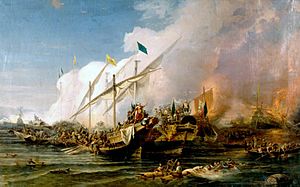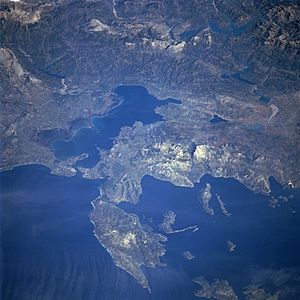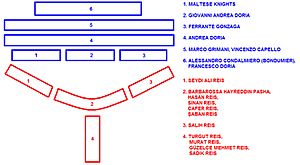Battle of Preveza facts for kids
Quick facts for kids Battle of Preveza |
|||||||
|---|---|---|---|---|---|---|---|
| Part of the Third Ottoman–Venetian War | |||||||
 Battle of Preveza, Ohannes Umed Behzad |
|||||||
|
|||||||
| Belligerents | |||||||
|
Holy League:
|
|||||||
| Commanders and leaders | |||||||
|
|
||||||
| Strength | |||||||
| 122 galleys 20,000 soldiers |
112 galleys 50 galleons 140 barques 60,000 soldiers |
||||||
| Casualties and losses | |||||||
| 400 killed 800 wounded |
Thousands killed 3,000 captured 128 ships sunk, destroyed or captured |
||||||
The Battle of Preveza was a big naval battle that happened on September 28, 1538. It took place near Preveza, a town in Greece, in the Ionian Sea. This battle was fought between the powerful Ottoman Empire's navy and a group of Christian European countries called the Holy League. The Ottomans won a major victory, which helped them control the Mediterranean Sea for many years. This battle happened in the same area as the ancient Battle of Actium in 31 BC. It was one of the three largest sea battles in the Mediterranean during the 1500s.
Contents
Why the Battle Happened

In 1537, a famous Ottoman admiral named Hayreddin Barbarossa led a large fleet. He captured many islands in the Aegean Sea and Ionian Sea that belonged to the Republic of Venice. These islands included Syros, Aegina, Ios, Paros, Tinos, Karpathos, Kasos, and Naxos. This meant the Ottoman Empire took over the Duchy of Naxos.
Barbarossa then tried to capture Corfu, a strong Venetian island, but he was not successful. He also attacked the coast of southern Italy, which was controlled by Spain.
Because of these attacks, Pope Paul III decided to create a "Holy League" in February 1538. This group included the Papal States (lands controlled by the Pope), Habsburg Spain, the Republic of Genoa, the Republic of Venice, and the Knights of Malta. Their goal was to stop the Ottoman fleet led by Barbarossa.
The Fleets and Their Leaders
Barbarossa's Ottoman fleet had 122 galleys and smaller ships called galliots that summer. The Holy League had a much larger fleet of 300 galleys and galleons.
- The Venetian fleet had 55 galleys.
- The Genoese and Papal fleets combined had 61 galleys.
- The Knights of Malta sent 10 galleys.
- Spain sent 50 galleys.
The overall commander for the Holy League was Andrea Doria. He was a Genoese admiral who worked for Emperor Charles V of Spain.
How the Fleets Lined Up
The Holy League's fleet gathered near the island of Corfu. The Papal fleet, led by Admiral Marco Grimani, and the Venetian fleet, led by Vincenzo Capello, arrived first. Andrea Doria joined them with the Spanish-Genoese fleet on September 22, 1538.
Before Doria arrived, Grimani tried to land soldiers near the Fortress of Preveza. However, he had to go back to Corfu after many of his soldiers were hurt fighting the Ottomans.
Barbarossa was still at the island of Kos in the Aegean Sea. But he soon arrived at Preveza with the rest of the Ottoman fleet. On his way, he captured the island of Kefalonia. One of his officers, Sinan Reis, suggested landing soldiers at Actium, a place near Preveza. Barbarossa didn't like the idea at first, but it turned out to be very important for the Ottoman victory.
With the Ottomans holding the fortress at Actium, they could use their cannons from land to help Barbarossa's fleet. This meant Doria had to keep his ships far from the coast. The Holy League tried two more times to land their forces near the fortress of Preveza, but Ottoman forces stopped them on September 25 and 26.
Doria's ships stayed far from the coast because he was worried about strong winds pushing them onto the shore. Barbarossa, however, had a better position closer to land. On the night of September 27–28, Doria sailed 30 miles south and anchored near the island of Lefkada. He and his commanders decided their best plan was to attack towards Lepanto to force Barbarossa to fight.
The Battle Begins
At dawn, Doria was surprised to see the Ottoman ships coming towards him. Barbarossa had moved his fleet out of its anchorage and was also heading south. Turgut Reis was at the front with six fast ships.
Doria did not expect such a bold attack from the Ottoman fleet, which had fewer ships. It took him three hours to get his ships ready for battle, even though Grimani and Capello urged him to act quickly.
The two fleets finally met on September 28, 1538, in the Gulf of Arta, near Preveza.
The lack of wind was a problem for Doria. The huge Venetian flagship, the Galeone di Venezia, with its powerful cannons, was stuck four miles from land. Christian ships struggled to reach it. The Galeone di Venezia was soon surrounded by enemy galleys. It fought bravely for hours, causing a lot of damage to the Ottoman galleys.
When the wind finally picked up, the Christian fleet moved closer. Doria tried some moves to draw the Ottomans further out to sea. Ferrante Gonzaga, the Viceroy of Sicily, was on the left side of the Christian fleet. The Knights of Malta were on the right. Doria put four of his fastest galleys under his nephew, Giovanni Andrea Doria, in the center front. Doria's own galleys formed a long line behind them. Behind them were the Papal and Venetian galleys. At the very back were the Venetian galleons and the Spanish-Genoese galleons, along with support ships.
The Ottoman fleet was shaped like a "Y". Barbarossa was in the center with his son and other commanders. Seydi Ali Reis led the left side, and Salih Reis led the right. Turgut Reis commanded the back. The Ottomans quickly attacked the Venetian, Papal, and Maltese ships. But Doria hesitated to bring his main force into the fight against Barbarossa. This led to a lot of maneuvering but not much actual fighting.
Barbarossa wanted to use the lack of wind to his advantage. The Christian "barques" (large sailing ships) were stuck without wind. These ships made up most of the difference in numbers between the two sides. The barques became easy targets for the Ottomans, who boarded them from their faster galleys. Doria's plan to trap the Ottoman ships between his cannons failed.
By the end of the day, the Ottomans had sunk, destroyed, or captured 128 Christian ships. They also took about 3,000 prisoners. The Ottomans did not lose any ships, but they had 400 killed and 800 wounded. However, some Ottoman ships were badly damaged by the powerful cannons of the Galeone di Venezia.
The next morning, with a good wind, Doria decided to leave the battlefield and sail to Corfu. He did not want to risk his Spanish-Genoese ships. He ignored the pleas from the Venetian, Papal, and Maltese commanders to keep fighting.
What Happened After
Many people believe that Andrea Doria hesitated and didn't fight with all his might because he didn't want to risk his own ships. He personally owned many of the "Spanish-Genoese" ships. Also, he had a long-standing rivalry with Venice, which was his home city's main competitor and the target of Ottoman attacks at that time.
In 1539, Barbarossa returned and captured almost all the remaining Christian outposts in the Ionian and Aegean Seas.
A peace treaty was signed between Venice and the Ottoman Empire in October 1540. Under this treaty, the Ottomans gained control of Venetian lands in the Morea (southern Greece) and Dalmatia (a region in Croatia). They also took over islands in the Aegean, Ionian, and eastern Adriatic Seas that used to belong to Venice. Venice also had to pay a large sum of money, 300,000 gold ducats, to the Ottoman Empire.
With their victory at Preveza and later at the Battle of Djerba in 1560, the Ottomans successfully stopped Venice and Spain from controlling the Mediterranean Sea. The Ottoman Empire remained the strongest naval power in the Mediterranean until the Battle of Lepanto in 1571.
Nicolò Zen the younger wrote a book called History of the War between Venice and the Turks. In it, he criticized those who had pushed for the war against the Ottomans but then fought poorly. His book was not published, but a copy survived and is now kept in a library in Venice.
See also
 In Spanish: Batalla de Préveza para niños
In Spanish: Batalla de Préveza para niños


